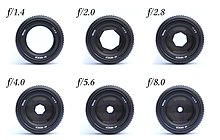Stopping down

In
: 112Reducing the aperture size increases the
signal gain of the sensor by increasing the camera's ISO setting. Alternatively, more light can be added to the scene by increasing the amount of light illuminating the scene, such as by using or increasing the strength of electronic flash or other light sources.[3]
As a lens is stopped down from its maximum (widest) aperture, most lens aberrations (
coma and astigmatism) are decreased, but lens diffraction increases. The effect is that for most lenses, the balance between the decreasing aberrations and the increasing diffraction effects of stopping down the lens means that lenses have an optimum aperture for best results, often about three stops closed down from maximum aperture, so for a lens with a maximum aperture of ƒ/2.8, ƒ/8 would be the optimum aperture.[2]
: 180
References
- ISBN 978-0205933808.
- ^ ISBN 978-0240520377.
- ISBN 978-0240521916.
